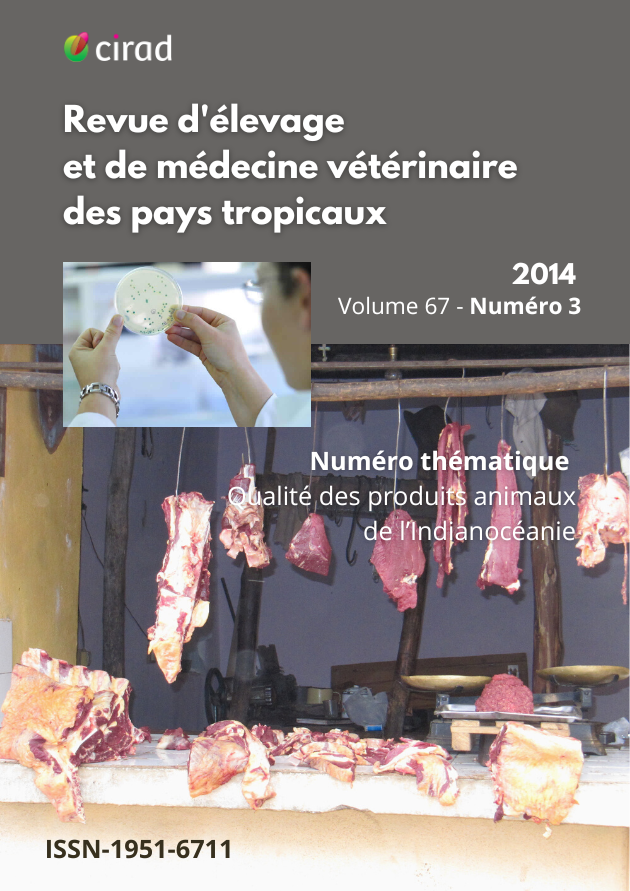Improving the smoking process of kitoza, a traditional Malagasy meat product
DOI:
https://doi.org/10.19182/remvt.10179Keywords
Smoked meat, Food quality, MadagascarAbstract
Kitoza is a traditional Malagasy meat product made from beef or pork. It is presented as 20–50 cm x 2–3 cm strips. Considered for a long time as a royal delicacy (1, 4), it still holds a special place in the daily meal of Malagasy people. Strips are salted, sun-dried and/or smoked either above the fire in the kitchen until consumption (2, 3) or in smoking units. Kitoza is no longer only prepared by housewives, it is also produced today commercially in modern facilities (butchers’ shops and a few processing firms). Processing techniques of the product are not always controlled and frequently cause variations in quality. Meat smoking can lead to contamination by polycyclic aromatic hydrocarbons (PAH) which are carcinogenic compounds (6). Among them, benzo(a)pyrene (BaP) is a good indicator of carcinogenic compound contamination in cooked and smoked meat products.
This study aimed to improve the smoking process of kitoza in order to reach moisture and phenol contents close to the traditional product, while decreasing the PAH content by using charcoal and sawdust, since products smoked with these fuels show acceptable PAH levels (below European norms) (5). The unit operations of drying/cooking and smoking were also separated to ensure sufficient smoking and conduct drying/cooking in a configuration which might not generate PAH.
The raw material used was pork ham cut into strips that were then salted at 10 g/kg of meat. Kinetics of water loss, phenols and BaP gain during smoking assays with only wood, and assays alternating cooking/drying with charcoal and smoking with sawdust phases were assessed. The different treatments consisted in: (i) cooking/drying with charcoal (4 h) and smoking with sawdust (2 h), (ii) smoking with sawdust (2 h) and cooking/drying with charcoal (4 h), and (iii) cooking/drying/smoking with small bricks of wood (6 h). Each treatment was repeated three times.
Figure 1 shows the evolution of the air temperature in contact with the meat during smoking. We tried to stabilize the smoking unit temperature at about 100°C, since it was the average temperature in the traditional smoking process. The temperature in the traditional process seemed 10-20°C below those of the experimental treatments (Figure 2). However, Figure 3 shows that water contents (55%) were not significantly different in experimental Kitoza compared to the traditional one. After 6 hours of heat treatment, the moisture content was between 40 and 50%.
Kinetics of total phenol accumulation on meat strips (expressed on a dry basis) are shown in Figure 4. The traditional process reached about 5 mg/100 g total phenols at end point. The charcoal-sawdust treatment induced a slight and linear increase in phenols as soon as sawdust was added (i.e. after 4 hours of charcoal cooking/ drying). Phenol content reached about 4 mg/100 g after 2 hours of smoking, a value close to that of the traditionally-processed product. Phenol contents obtained with sawdust-charcoal and wood treatments reached higher levels (about 10 mg/100 g) than that of the traditional one (5 mg/100 g). The sawdust-charcoal treatment provoked very fast and efficient phenol deposit in the beginning, comparable to that of wood alone. It could be explained by the high moisture content of the surface layers of the meat strips in the first period of the process. The phenol content peaked after about one hour of exposure to sawdust smoke. The phenol content remained then unchanged until the end of the process. Since this parameter was expressed on a dry basis, it would mean that the deposited phenols remained in the meat strips and were not destroyed neither did they evaporate. Figure 5 shows the kinetics of BaP accumulation on strips on a wet basis. Regardless of the duration of charcoal-sawdust or sawdust-charcoal treatments, BaP contents were lower than 2 μg/kg. For these two treatments, a slight increase was recorded after 3 hours in relation with the concentration effect due to water evaporation. In the wood treatment, accumulation was linear and BaP reached very high levels: 20 ppb after 2.5 hours and 40 ppb after 6 hours. In the traditional process, 8 ppb were reached after 2.5 hours. In the latter two cases, this could be related to wood pyrolysis at high temperature in a system allowing direct exposure to fire.
Processes without wood are very promising to reduce PAH accumulation during drying and smoking. Compared with the traditional process, splitting operations between cooking/drying with charcoal on one hand, and smoking with sawdust on the other hand allowed the same decrease in water content, effective phenol deposit which could be modulated according to the desired result, and decrease in PAH content in compliance with new European Union regulations. Reengineered products will be subjected to sensory and consumer acceptance analyses with Malagasy consumers, and the duration of preservation will also be assessed.
Downloads
Downloads
-
Abstract1218
-
PDF228
Received
Accepted
Published
How to Cite
Issue
Section
Categories
License
© A.Ratsimba et al., hosted by CIRAD 2014

This work is licensed under a Creative Commons Attribution-NonCommercial-ShareAlike 4.0 International License.






